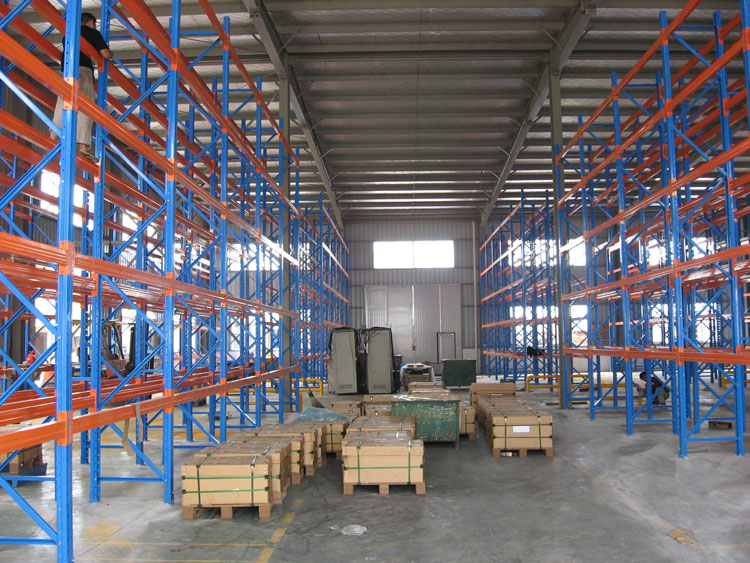Here are the steps and considerations to design a pallet rack to maximize its storage capacity:
1. Analyze the Pallets and Goods
Understand Pallet Dimensions:
Measure the length, width, and height of the pallets you will be using. Standard pallet sizes vary, such as the 48-inch by 40-inch (1219 mm by 1016 mm) pallet in North America. Make sure the rack bays are designed to accommodate these dimensions precisely. For example, if the pallet length is 48 inches, the bay length could be designed to be 49 – 50 inches to allow for easy loading and unloading while minimizing wasted space.
Weight and Load Capacity:
Determine the maximum weight of the pallets when fully loaded. This information is crucial for selecting the appropriate rack components with sufficient load-bearing capacity. For heavy-duty applications, such as storing industrial machinery parts on pallets, you may need thicker-walled uprights and stronger cross-beams to support the weight.
2. Choose the Right Rack Type and Configuration
If quick access to individual pallets is essential, selective pallet racks are a good option. To maximize capacity, consider the following:
Height: Increase the height of the racks as much as possible, subject to the limitations of your building height and forklift reach. Taller racks can store more pallets vertically. For example, if the height of a standard pallet is 6 inches and your building allows for a 30 – foot – high (360 inches) rack, you could potentially store up to 60 pallets vertically.
Aisle Width: Minimize the aisle width while still allowing safe forklift operation. Narrow-aisle forklifts can operate in aisles as narrow as 5 – 6 feet, compared to traditional forklift aisles that can be 10 – 12 feet wide. This allows more floor space to be dedicated to the racks.
Drive-In/Drive-Through Racks:
These are ideal for high-density storage. For drive – in racks, pallets are stored in a last – in – first – out (LIFO) order, and for drive – through racks, it’s first – in – first – out (FIFO).
Depth: Design the racks with an appropriate depth to store multiple pallets in a single bay. However, be aware that deeper racks may make it more difficult to access pallets located further back. The depth can range from a few pallets deep (e.g., 3 – 5 pallets), depending on the forklift’s reach and the weight of the pallets.
Push-Back Racks:
Push-back racks can store multiple pallets deep while still providing relatively quick access to the front pallets. The angle of the push-back rails should be optimized to ensure smooth pallet movement. Typically, the angle can range from 2 – 5 degrees to allow pallets to slide back easily when a new pallet is loaded.
3. Optimize the Rack Dimensions
Bay Width and Depth:
As mentioned earlier, the bay width should match the pallet width as closely as possible. For the depth, consider the pallet length and the number of pallets you want to store in a single bay. For example, if you want to store 3 pallets of 48 – inch – long pallets in a bay, the bay depth could be around 144 – 150 inches (allowing for some space between pallets).
Vertical Spacing of Beams:
The cross-beams that support the pallets should be spaced to provide adequate support without sacrificing too much vertical storage space. For most pallets, a beam spacing of 4 – 6 feet vertically can work well. This allows for the pallets to be stable and also provides enough room to store multiple pallets.
4. Consider the Storage Environment and Handling Equipment
Forklift Compatibility:
Ensure that the rack design is compatible with the forklifts or other handling equipment you will be using. The height of the pallet entry points, the aisle width, and the turning radius of the forklift all need to be considered. For example, if you have a forklift with a maximum lift height of 20 feet, the rack height should be designed so that the top-most pallets can be easily accessed by the forklift.
Space Utilization:
Take advantage of the available space in the warehouse. If there are odd-shaped areas or corners, consider using custom-designed pallet racks or modular rack systems to fit those spaces. You can also use mezzanine floors above the pallet racks to create additional storage areas if the building height allows.
5. Ensure Safety and Durability
Load-Bearing Capacity:
The rack components, including the uprights and beams, should have a sufficient safety margin in terms of load-bearing capacity. This not only ensures the safety of the stored goods and the operators but also allows for potential future increases in the weight of the stored pallets. For example, if the maximum expected load per pallet is 2 tons, the rack components should be designed to handle at least 2.5 – 3 tons per pallet location to account for any unforeseen circumstances.
Bracing and Stability:
Incorporate proper bracing and stability features into the rack design. Diagonal bracing between uprights can enhance the overall stability of the rack, especially for taller racks. The base of the rack should also be securely anchored to the floor to prevent tipping.
Post time: Apr-29-2025

